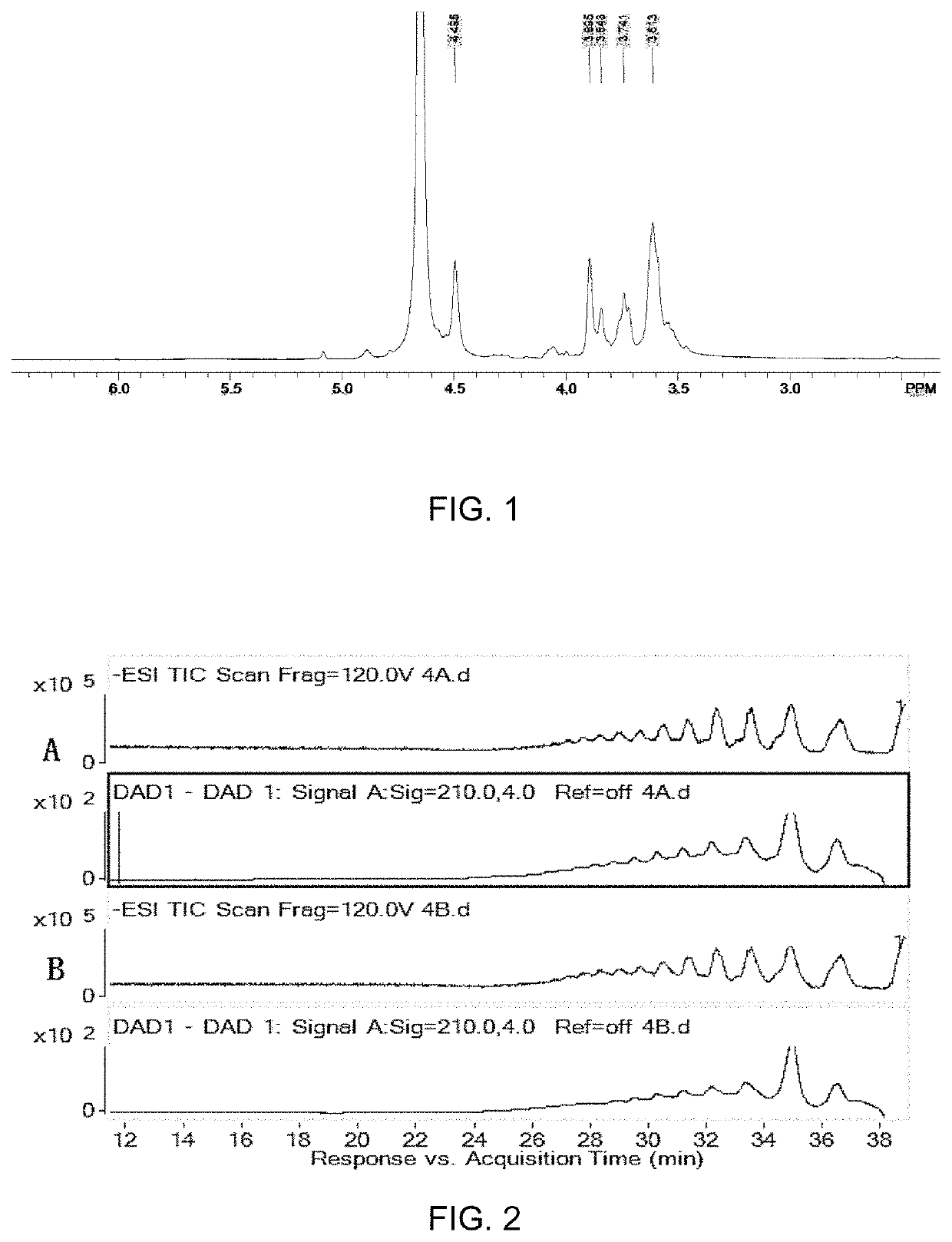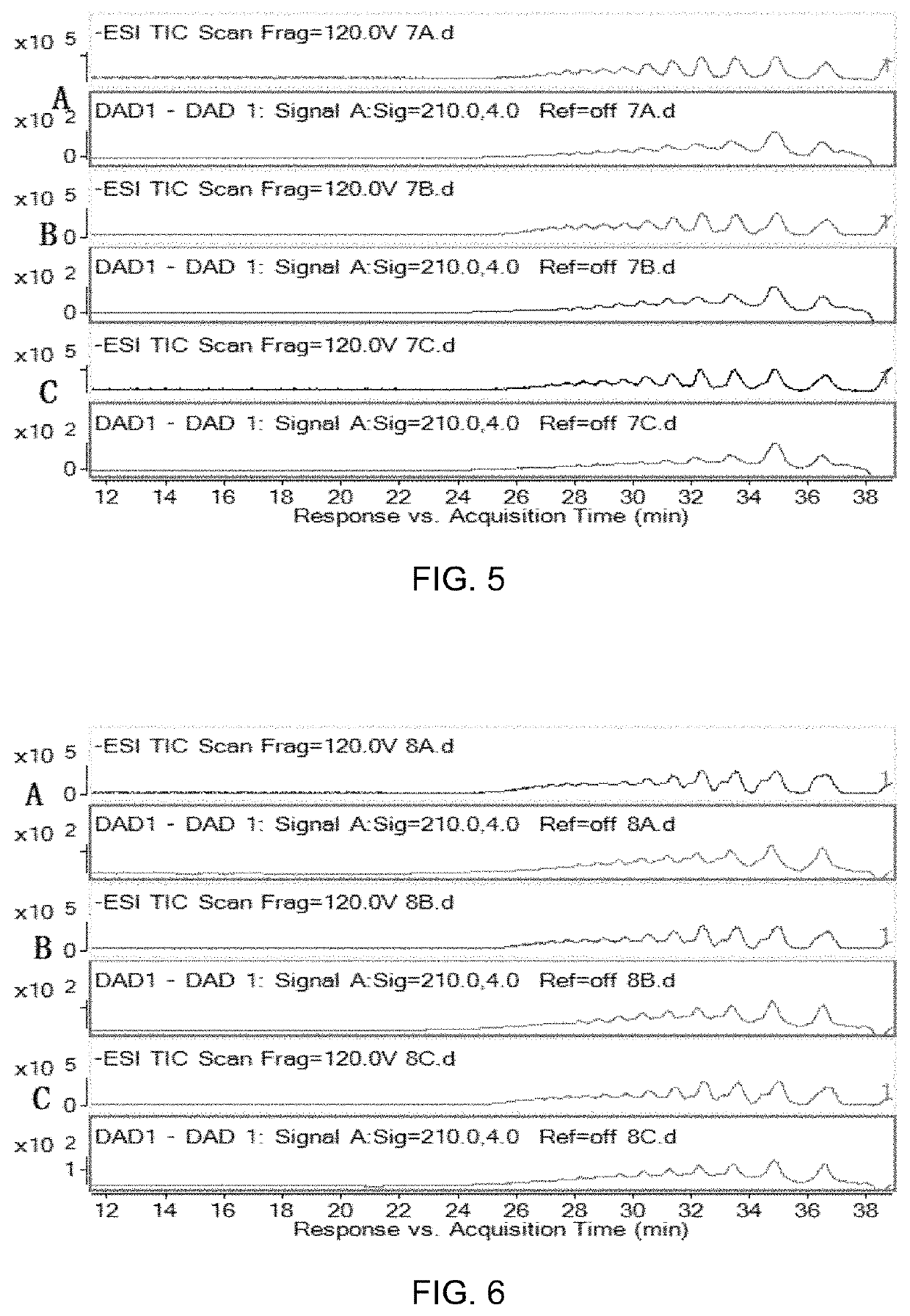Method for preparing oligomeric mannuronic diacid
a technology of mannuronic diacid and mannuronic acid, which is applied in the field of preparing oligomannuronic diacids, can solve the problems of long production period, high cost of biological fermentation and enzymatic catalysis, and the above methods are insufficient, so as to achieve fast rate, low cost, and high yield
- Summary
- Abstract
- Description
- Claims
- Application Information
AI Technical Summary
Benefits of technology
Problems solved by technology
Method used
Image
Examples
example
Example 1
[0050]Step 1): Preparation of M-Segment Oligosaccharides
[0051]1500 g M-segment intermediates were weighted and dissolved with distilled water to formulate a solution of 7500 ml volume. The solution was adjusted to pH 3.5 with concentrated hydrochloric acid, divided into several parts, placed into an autoclave to heat at 110° C. for 3.5 hours, cooled and removed, concentrated in a rotary evaporator, and dried in a vacuum oven at 60° C. to obtain 1515 g M-segment oligosaccharides.
[0052]The M-segment oligosaccharides were qualitatively analyzed by HPLC-MS. HPLC conditions: chromatographic column, Waters ACQUITY UPLC BEH125 SEC 1.7 μm, 4.6×300 mm; mobile phase: 50 mM NH4Ac dissolved in 20% methanol-water, flow rate of 0.1 ml / min; sample concentration: 1 mg / ml; injection volume: 8 μl; column incubator temperature: 30° C.; detector: DAD detector, 210 nm. MS conditions: Agilent 6540 QTOF; ion source: ESI; fragmentation voltage: 120V; anion mode.
[0053]The M-segment oligosaccharide ...
example 2
[0059]100 g of the M-segment oligosaccharides prepared in Example 1 was placed into a 5 L glass beaker, dissolved with 1 L distilled water, added with 1 L of 1 M Na2HPO4, adjusted to pH 6.5 with concentrated hydrochloric acid, heated to 40° C. in water bath, and stirred. 1.7 L of commercially available 3% bromine water was slowly added within 10 minutes. After continually stirring for 3 hours, the reaction was terminated by adding 2 fold volume of 95% ethanol and the products were precipitated. The precipitate was dissolved with a suitable amount of water, and the alcohol precipitation operation was repeated once. At last, the precipitate was dried in a vacuum oven to obtain a 96 g brown brick solid, with a yield of about 96%. The composition of the solid substance was analyzed by HPLC-MS, with the same experimental conditions as Example 1. The SEC-HPLC analysis result is shown in FIG. 2A.
example 3
[0060]100 g of the M-segment oligosaccharides prepared in Example 1 was placed into a 5L glass beaker, dissolved with 1 L distilled water, added with 1 L of 1 M Na2HPO4, adjusted to pH 9.5 with concentrated hydrochloric acid, cooled to 10° C. in water bath by adding a suitable amount of ice, and stirred. 4.7 L of commercially available 3% bromine water was slowly added within 10 minutes. After continually stirring for 1 hour, the reaction was terminated by adding 2 fold volume of 95% ethanol and the products were precipitated. The precipitate was dissolved with a suitable amount of water, and the alcohol precipitation operation was repeated once. At last, the precipitate was dried in a vacuum oven to obtain a 94 g brown brick solid, with a yield of about 94%. The composition of the solid substance was analyzed by HPLC-MS, with the same experimental conditions as Example 1. The SEC-HPLC analysis result is shown in FIG. 2B.
PUM
| Property | Measurement | Unit |
|---|---|---|
| temperature | aaaaa | aaaaa |
| temperature | aaaaa | aaaaa |
| chemical shift | aaaaa | aaaaa |
Abstract
Description
Claims
Application Information
 Login to View More
Login to View More - R&D
- Intellectual Property
- Life Sciences
- Materials
- Tech Scout
- Unparalleled Data Quality
- Higher Quality Content
- 60% Fewer Hallucinations
Browse by: Latest US Patents, China's latest patents, Technical Efficacy Thesaurus, Application Domain, Technology Topic, Popular Technical Reports.
© 2025 PatSnap. All rights reserved.Legal|Privacy policy|Modern Slavery Act Transparency Statement|Sitemap|About US| Contact US: help@patsnap.com



